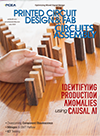Products
Photo Stencil aquired the AMTX E-Blade electroformed squeegee blade from Xerox. It is said to improve printdeposition, quality, uniformity and consistency. With a rigid, low-friction, hard-nickel edge, the blade provides cleaner prints, reduced stencil wear and less material waste.
"The electroformed E-Blade demonstrated the lowest squeegee pressure of any other squeegee blade I have tested for both SMT and wafer bumping printing," said Rick Lathrop, technical service manager of surface-mount materials at Heraeus. Heraeus recently completed a study on squeegee blades. "With lower print pressures come all of the benefits of reduced understencil wiping frequency and increased stencil life. The lack of paste scooping in large apertures for wafer bumping can only enhance bump coplanarity for automotive and WLCSP applications."
The blade also addresses issues caused by Pb-free printing. Pb-free solder paste requires higher squeegee pressures for a clean wipe of the stencil. The E-Blade prints at 33% of the squeegee pressure of other popular squeegee blades. High squeegee pressures result in "smear mode" printing whereas low squeegee pressure allows "sheer mode" printing.
Photo Stencil, www.photostencil.com
Almit Technology will debut a new Pb-free paste at Nepcon UK this April, created specifically for printing at up to four-times the normal printer excursion speed. LFM-48 TM HP solder paste reportedly enables increased productivity, allowing European assemblers to bid successfully against competitors in low labor cost countries.
The paste is said to exhibit good wetting, high definition printing with long screen and tack life. It is approved and adopted by major manufacturers worldwide for open blade printing and enclosed print head systems.
For through-hole assembly and rework, Almit has also introduced cored solder wire featuring 96.5%Sn-3%Ag-0.5%Cu alloy. KR-19SH RMA wire retains the benefits of the original product to deliver wetting, high reliability and low residue. It is available in diameters from 0.3 to 1.6 mm on 0.5Kg reels – and in selected sizes on anti-static Handy Reels.
Almit Technology Ltd., almit.com
Visit Stand C2 at Nepcon UK
Tyco Electronics’ Global Application Tooling Division (GATD) has collaboratively worked with Graphic Solutions International (GSI) to provide them with an RFID Inlay assembly system. This equipment will assemble semiconductor chips, surface-mount devices and printed batteries onto a continuous web of printed antennas, adding RFID capability to tags and labels.
Working closely with GSI, Tyco provided a reel to reel system that allows GSI to mount flip-chips, SMDs and printed batteries on a continuous web of printed antennas and conductive traces. The system is capable of the high-speed mounting of electronic components on a 6,000'+ (1,800+ m) roll of 20" wide material. After conductive printing, the roll is fed into the Tyco machine where components are added along with one or two printed batteries. Upon completion, the roll can be slit into individual streams and rolled, or supplied in production web width rolls for delivery. A typical circuit is inlaid with batteries, an RFID chip and a printed antenna. Its speed allows for production levels up to 26 million inlays per year.
The continuous web assembly system produces inlays that offer performance improvements over conventional PCBs. The system allows mounting flip chips for almost any purpose, as well as the ability to mount most standard SMDs along with GSI’s printed batteries. Can mount on paper, PET or other flexible substrates, and features a variable width capability up to 20" wide. Can accommodate printed substrates from 0.002" to 0.005" thick, mount on continuous rolls with a repeat pitch of 0.8" and position chips to micron accuracy.
Graphic Solutions International, graphicsolutionsinc.com
Tyco Electronics, tycoelectronics.com.
Press Releases
- Seika Machinery to Host Webinar on Wireless Strain Measurement for PCB Testing
- NEPCON ASIA 2025: Innovating Smart Manufacturing Ecosystems and Bridging Global Opportunities
- Viasion Technology Expands Global Reach as a Trusted PCB Manufacturer and EMS Provider in China
- Viasion Technology Expands Global Reach as a Trusted PCB Manufacturer and EMS Provider in China


